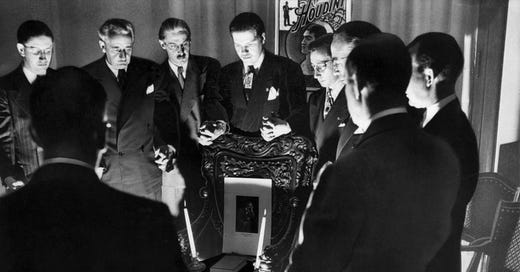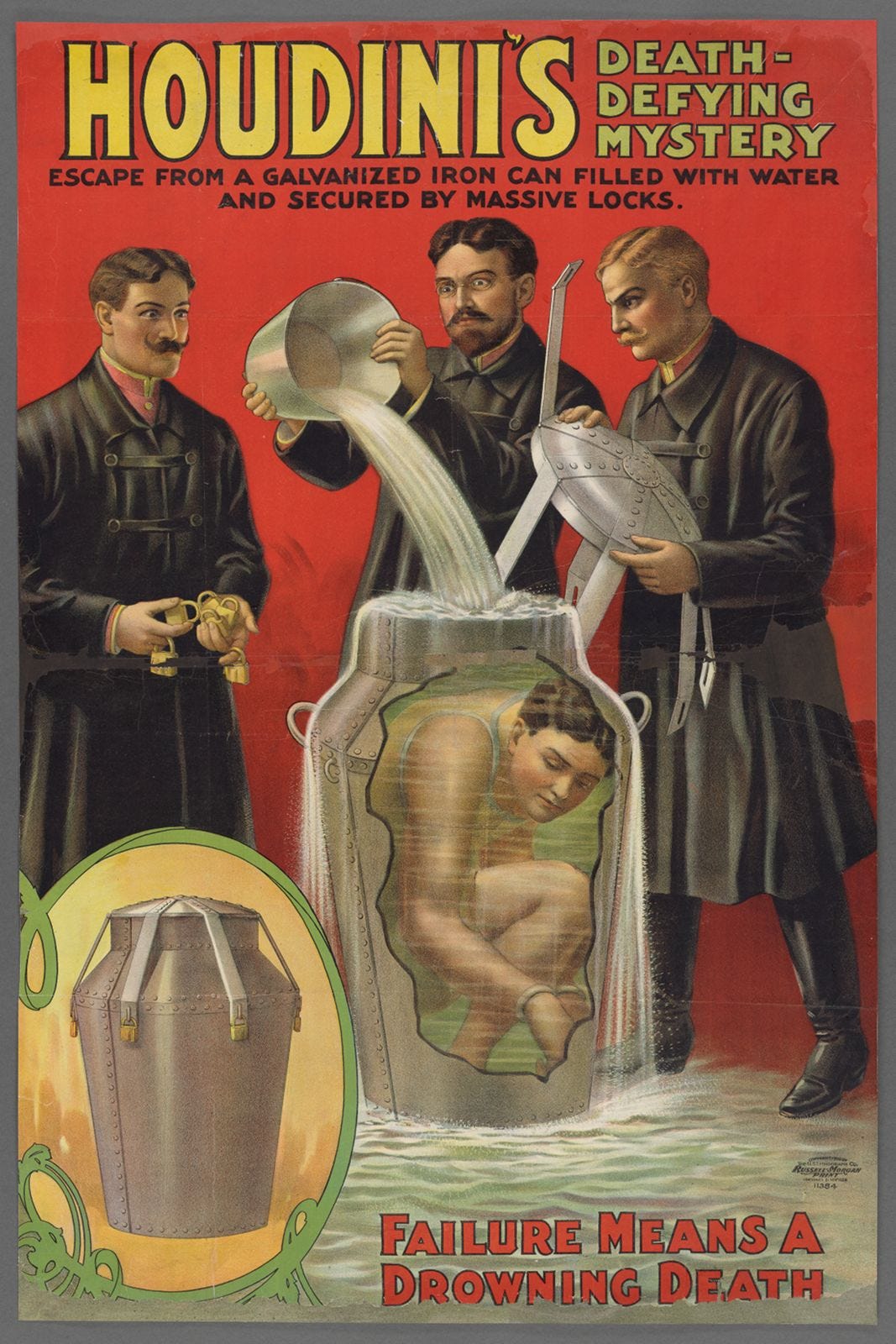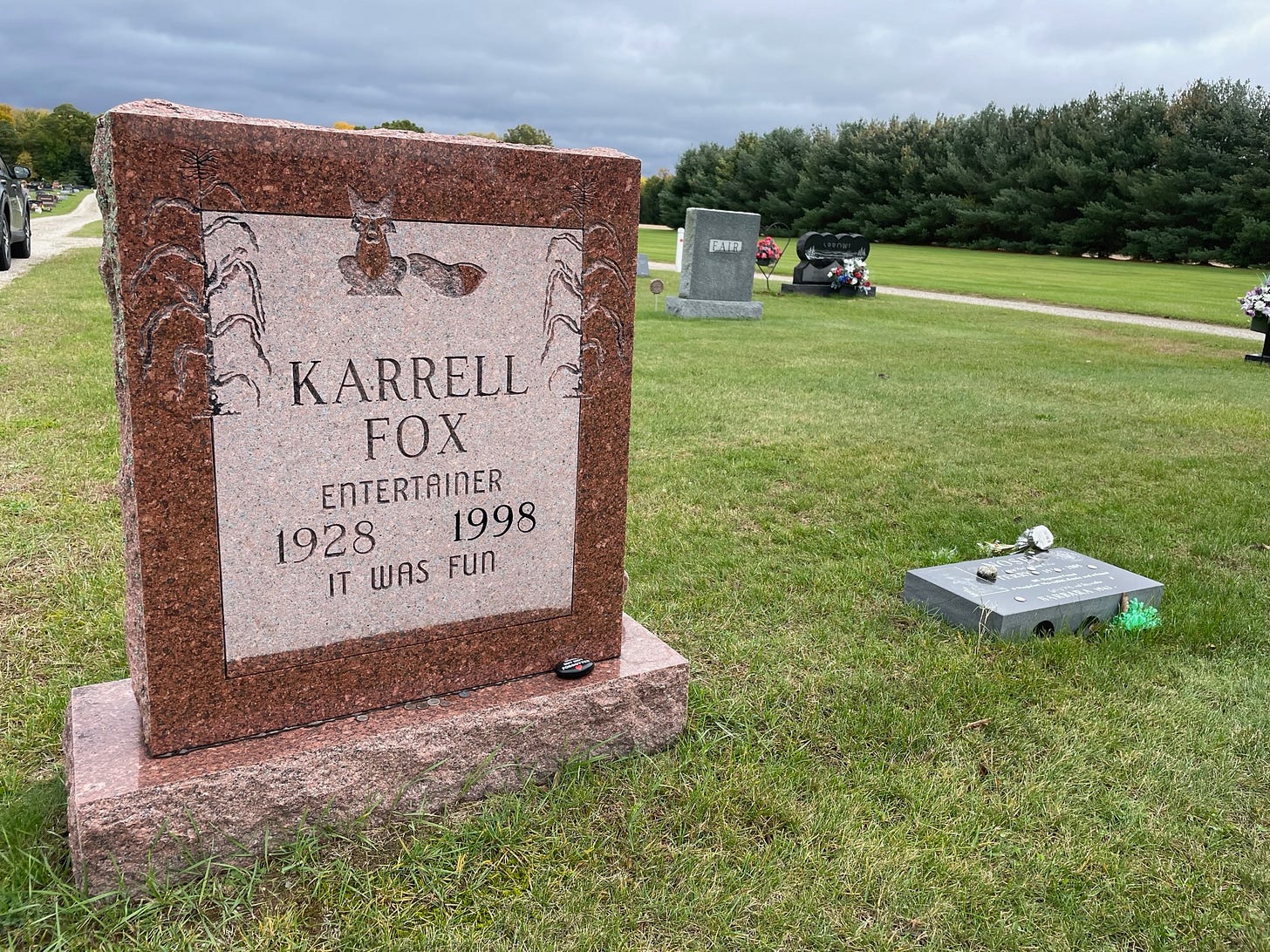The 1946 Houdini seance in Detroit. Karrell Fox is standing over the chair. Granger/Bridgeman Images.
It feels a little tired to write about Houdini and Halloween, like a last resort. You know the basics: Houdini died in Detroit on Oct. 31, 1926, at Grace Hospital (demolished: 1979), after an Oct. 24 performance at the Garrick Theatre (demolished: 1928-29). The cause of his death was peritonitis, set on after an appearance in Montreal two days earlier, where he was punched by a fan who was trying to see for himself if Houdini really had an iron stomach. Do we know if the punches ruptured his appendix? We do not, but that’s the story we all grew up hearing about the death of Houdini. In Detroit!
His body was embalmed at the William R. Hamilton funeral home on Cass Ave., which has not been demolished, although it has been vacant forever. Then, his body was sent by train to New York, where he was buried at a Jewish cemetery in Queens.1
Houdini spent a lot of time in his life trying to debunk Spiritualism and its mediums and seances.2 How would Houdini feel about the fact that for this reason, people have been hosting seances specifically to try to stir up his spirit for nearly 100 years? So long as he continues to not show up for these seances, we’ll never know.
The seances started with Houdini’s widow Bess, who held one every year on Halloween until 1936, because Houdini had promised he would try to reach her after death if it turned out he could. She gave up after 10 years, declaring it “long enough to wait for any man.”
Ten years after that, on Halloween 1946, a group of Detroit magicians gathered in the basement of the Tuller Hotel (demolished: 1991) to try to conjure up Houdini’s spirit. The seance was organized by Detroit magician Karrell Fox3, who wagered that Houdini might show up for a group of fellow magicians.
“A portrait of Houdini was placed on the seat of a chair, leaning against the straight back. Beside the portrait was an autographed book written by the late magician. Other props included a pair of handcuffs used by Houdini in his last performance at the old Garrick Theater, shortly before his death; two lighted candles on either side of the book and a magic wand,” the Detroit Free Press reported in its story on the seance — witnessed by “three skeptics and newspapermen to make sure everything is bonafide” — on Nov. 1, 1946.
Houdini did not show up for the Detroit magicians. “Houdini did a non-appearing act,” read one headline that I laughed at all day.
Houdini historian John Cox makes the case that the 1946 Detroit Houdini seance was, in fact, the first magician-organized Houdini seance, of which there have been a great many since. I started to learn about magic history like three weeks ago so I don’t feel qualified to evaluate this argument, but if it’s a “first” and it’s “in Detroit,” you know I’ll be more than happy to believe it.
The American Museum of Magic in Marshall, Mich. The skeleton outside is dressed up like Houdini doing an underwater strait jacket escape.
Another notable Houdini seance happened somewhat locally at the American Museum of Magic in Marshall, Mich. in 1978. It was, its organizers claimed, the first Houdini seance held in the daytime, at 1:15 p.m.
To entice the spirit, a plate of lox and bagels were placed inside of Houdini’s trick milk can, a centerpiece of the museum’s collection. “Houdini was Jewish and lox and bagels were his favorite snacks,” Robert Lund, the museum’s founder, told a Free Press reporter. (Lund himself had worked as a Free Press reporter when he was 18 years old; he went on to become an automotive reporter and editor of some renown and is in the Michigan Automotive Hall of Fame.)4 The museum held another Houdini seance in 2016, on the 90th anniversary of Houdini’s death. Both times, Houdini was a no-show.
“Houdini’s Death-Defying Mystery” poster, 1908, via the New York Public Library.
Reading up on Karrell Fox and the magic scene of mid-century Detroit led me pretty quickly to Lakeside Cemetery in Colon, Mich., the famous “magician cemetery” where more than 30 magicians are interred — the most magician gravesites anywhere, probably.
The tradition started, the story goes, with magician Harry Blackstone, a Chicago native who chose the small Michigan town as his summer home-base in 1926. (It was his wife, Inez, who had discovered it on a random drive south from Kalamazoo, and who put down the money for some land on Sturgeon Lake that would become known as Blackstone Island.) One summer, the Australian magician Percy Abbott came to visit and ended up settling down in Colon, too. Blackstone and Abbott started a magic shop in Colon together, had a terrible falling-out, closed the magic shop and never spoke again. But by then the magic had already happened (sorry). Abbott launched his own enterprise, the Abbott Magic Co., in Colon in 1934. The following year, Abbott’s Magic Get-Together was first gotten together; it is still held in Colon every year.
Blackstone, meanwhile, continued to call Colon his home until 1949, when he moved to California for health reasons. After he died in Hollywood in 1965, he was buried in Colon, and it started this whole thing, as more magicians over the decades decided to join him there. (As for Percy Abbott, who died in 1960, his ashes were scattered somewhere; there’s no sign of him at the magician cemetery.)
The grave of Harry Blackstone, decorated with flowers, coins, stones and other tokens.
I visited Lakeside Cemetery earlier this month, on a windy and golden fall afternoon. The cemetery is one of a dozen old rural graveyards along the route; it’s a little hidden in plain sight that way. Horse-drawn buggies clopped by every few minutes. I hadn’t been there long when two older gentlemen pulled up and got out at the magicians section — magicians themselves, they admitted, though they asked me not to publish their names. They showed me around and told me stories of the magicians of Lakeside, many of whom they knew personally or had seen perform — the vaudevillian Donald “Monk” Watson, at one time the master of ceremonies at the Grand Riviera Theatre in Detroit, who gave 5,000 consecutive performances there; Bill Baird, “the Magnificent Fraud,” known for his ability to manipulate billiard balls, who was rumored to have broken his pinky finger to aid in his dexterity; Walter “Zaney” Blaney, a magician and inventor who created a levitation table illusion beloved of David Copperfield. It’s right there on his tombstone.
The grave of Walter “Zaney” Blaney, whose epitaph reads “Die Young as Old as Possible.”
Little Johnny Jones, “The Conjuring Humorist,” d. 1995: “Now I have to fool St. Peter.”
The Lunds, founders of the American Museum of Magic, are here, too. And there’s a marker honoring Inez Blackstone Kitchen, who “with Harry … brought magic to Colon,” and who lived to be 94. The magicians told me she’s buried in Florida, not Colon, but it’s nice to see her place in the whole movement recognized here.
Robert and Elaine Lund, founders of the American Museum of Magic. Their tombstone reads “Among Friends,” which choked me up.
Memorial marker for Inez Blackstone Kitchen: “With Harry, she brought magic to Colon.”
I drove away dumbfounded — even sort of lovestruck — by my luck. (Luckstruck?) It felt literally magical. I asked the magicians if they visited Lakeside often, wondering what my odds were of running into them there. They told me they usually only go once a year, during the Get-Together, but one of them had missed the cemetery trip this year, so they were making up the time.
One of them said offhandedly — during some incredible story about some long-dead fellow magician — that the whole point of magic is to inspire wonder. This is obvious, but it was funny to hear as I was swimming in my own heady sense of it, grinning my way through this impromptu performance like a kid watching a rabbit come out of a hat.
As the spell of the leaves and the wind and the hoofbeats and the old magicians wore off over the next couple of days, I wondered if this whole encounter was in fact a kind of magic trick. Seriously: Did I set off some kind of alert at Colon magicians HQ when I drove through Lakeside’s gates? Does a rotation of magicians post up at the cemetery on October weekends to mesmerize people like me? I’ve been looking up the sleeves of this serendipitous event since then. But if it was something more than just my good luck: Would I really want to know? The classic, agonizing question about any kind of magic.
The grave of Karrell Fox, whose epitaph reads: “It was fun.”
Later I found this video of Karrell Fox giving a tour of the magicians’ cemetery, one not unlike the tour I took. It did sort of give me the sense of something handed down, a trick a master magician might learn from a mentor. But the magic of it didn’t change at all while I watched it. The magic came right back.
This is amazing: You are NOT allowed to visit Houdini’s grave on Halloween, because in the mid-1990s the state of New York decided that all the magicians gathering there to mark the anniversary of his death were bringing in the WRONG ELEMENT including VANDALS. I guess magicians now gather there on his birthday instead.
you listened to Ghost Church, right? so good.
Fox was especially well-known as a trade show magician and the creator of something called “The Magic World of Ford” which I am DY-ING to learn more about. He was also MILKY THE CLOWN, iykyk.
Elaine Lund was born at Grace Hospital in 1926, the same week Houdini died there. Robert Lund, a consummate collector, used to say that he had to marry her because she was a collector’s item. She reopened and expanded the American Museum of Magic after his death in 1995.











